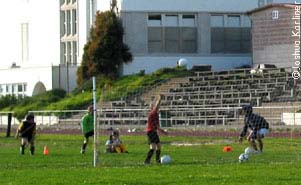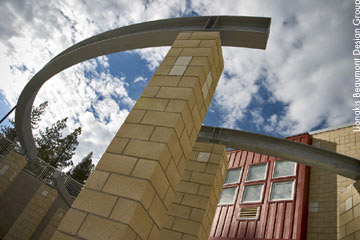INTRODUCTION
THE ECOLOGY OF SCHOOLSOne in five Americans—55 million people—spend their days in K–12 schools. Besides the students, they are teachers, administrators, nurses, janitors, and parent volunteers. This report—a product of a one year intensive focus on a plethora of issues involving schools, environment and health—is written as an encouragement for all of us who interact with schools in our personal and professional lives. It is not intended as a definitive statement on the questions involved. Rather, it aims to develop a vision of what our individual schools, districts, state and nation wide educational efforts could look like if we truly aimed to build healthy, ecologically sustainable institutions and communities.
At several points in this report you will be asked to imagine such a “green” alternative for a variety of contexts. This exercise is intended to give us all a chance to think outside of the box, to gain a sense of the possible and therefore the opportunity to actually move outside of that box as well. We will begin this exercise now.
 Sit back, close your eyes and imagine for a moment a truly healthy and sustainable school or school district. Imagine if all our schools were to strive to be toxics–free—making choices about chemical use that employ a precautionary approach aimed to prevent harm to children’s health. Imagine if US schools were geared to minimize their impacts on the local and global environment; imagine schools that generate their own energy, conserve water, are built with ecologically sound materials, reduce their overall resource consumption, reuse as many resources as possible, recycle the rest, and beyond that, purchase recycled paper, along with classroom and office supplies. Imagine schools that serve organic lunches produced by local farmers, and, in some cases by their own gardens. Imagine schools that engage the students in this transformation, using their healthy buildings, green school grounds and nutritious food as a grand teachable moment—a hands–on, place–based pedagogy that fosters an ecologically literate and engaged generation, and meets (now imagine this) new national and state environmental education standards.
Sit back, close your eyes and imagine for a moment a truly healthy and sustainable school or school district. Imagine if all our schools were to strive to be toxics–free—making choices about chemical use that employ a precautionary approach aimed to prevent harm to children’s health. Imagine if US schools were geared to minimize their impacts on the local and global environment; imagine schools that generate their own energy, conserve water, are built with ecologically sound materials, reduce their overall resource consumption, reuse as many resources as possible, recycle the rest, and beyond that, purchase recycled paper, along with classroom and office supplies. Imagine schools that serve organic lunches produced by local farmers, and, in some cases by their own gardens. Imagine schools that engage the students in this transformation, using their healthy buildings, green school grounds and nutritious food as a grand teachable moment—a hands–on, place–based pedagogy that fosters an ecologically literate and engaged generation, and meets (now imagine this) new national and state environmental education standards.
Of course, you may be saying, this is not a very pragmatic vision—even if it were desirable, it is not really possible given the current political and financial reality of education in America (not to mention the laws of entropy, bureaucracy and, for that matter, gravity). And if you’re saying this, in some ways you are right. For a quick reality check reveals a somewhat horrendous picture of American schools. Politics of all stripes whirls around education.
There’s barely enough money to pay enough teachers and keep our aging school buildings from falling apart to even begin to think about sustainability. Violence, drugs, overcrowding and unacceptable test scores top the long list of problems plaguing our schools. A stringent standards and test score–based approach to education is the austere cure proposed by the powers that be. And creeping privatization, along with hot button issues such as school vouchers lurk just around the corner. What’s more, you may ask, how can you even dream of green schools when our country’s overall priorities right now seem to be headed in the opposite, anti–environmental, direction?
In addition to asking you to imagine a new relationship between schools and environment, this report also provides a pragmatic reality check. Beyond the big picture problems mentioned above, in section after section this report finds that with precious few exceptions, our current school systems are threats to our children’s health, models of unsustainability, and significant contributors to society’s broader environmental and health problems.
The vast majority of US schools regularly expose students to pesticides and other hazardous chemicals. What’s more, according to the US Environmental Protection Agency “one–half of our nation’s 115,000 schools have problems linked to indoor air quality. Students, teachers and staff are at greater risk because of the hours spent in school facilities and because children are especially susceptible to pollutants.”1 Our schools are inefficient energy hogs whose electricity consumption alone is equivalent to 42 days of US imports of Saudi Arabian oil. While some schools are moving toward greater energy efficiency, many are not. And very few are investing in—or have the necessary incentives to invest in—clean, renewable energy.
What’s more, while residential recycling programs, as well as recycling in private office settings, have become the norm in this country, many school districts, if not the majority, do not recycle paper and office supplies—let alone purchase recycled products. Many morealso contribute to the country’s childhood obesity epidemic by serving unhealthy school lunches and increasingly allowing predatory fast food, soft drink and junk food companies to sell and advertise their products on school grounds in exchange for financial resources to support underfunded programs. Meanwhile, environmental education itself is severely underfunded, co–opted by polluting corporations and under attack by right–wing ideologues—contributing to an environmental “literacy gap” in our society.
Why is all of this so? There are, of course, many complex, often contradictory reasons. But one important challenge that we face in changing the situation is that the United States educational “system” is highly decentralized and fragmented. The federal government has a big say, but so do the education departments in each state, as do individual school districts. And of course, every principal wants to do what is best for his or her school. Even within each school, there is often a decentralized decision–making structure. For instance many school secretaries have total discretion as to what kind of paper to order, with budgetary considerations usually overriding all other concerns. So, how does one move the beast?
This has been a challenge for those environmental and children’s health advocates who have focused on schools—and for those who have become involved in these issues from their experience inside a school system. Perhaps because of the highly decentralized nature of our educational institutions, efforts to promote green and healthy schools are generally quite isolated from one another. This is especially true within fields such as environmental education, but it is also the case in terms of the relationship, or often lack thereof, between the different fields addressing the pressing issues such as green buildings, green school yards and gardens, children’s environmental health, environmental education and more. The absence of a greater coherence and vision among these constituencies weakens our ability to achieve more thoroughgoing change in our schools.
However, it is also extremely important to recognize all of the excellent work going on in these and other fields. Throughout this report you will find dozens of positive examples of organizations, school districts, educators, parents and others working for change and making some of it happen. These illustrations—along with the policy recommendations suggested under the “Steps Forward” heading in each section, are all drawn from a broad and deep pool of initiatives. It is this panoply of positive work, however fragmented it may be, that provides not only hope, but also the bricks and mortar from which the broad thoroughgoing change that this paper advocates can be built.
Finally, this report attempts to create a framework for such broad change—one that can begin to help pull together the many disparate yet very much related efforts in a common vision of transforming our country’s school systems. This vision contemplates green and healthy school systems as a metaphorical building. This edifice, described in the sections below, has a strong foundation of preventing harm (the Precautionary Principle). And it has four pillars supporting it—each of which is composed of a series of issues.
 |
Most of our schools are models of unsustainability and threats to our children’s health |
This school building exists within and as a central part of what we might call three ecosystems: First, is the school’s own physical ecosystem—the interrelated and interactive physical and natural elements of the school that exist inside the school grounds. Second is the learning ecosystem—the intellectual and hands–on tactile environment in which kids are taught. And third, there is the larger community, local watersheds and airsheds, bioregions and concrete jungles, all connected to the global ecosystem—the actual multi–layered physical environment within which a school exists, and with which it interacts.
It is important to recognize that creating this metaphorical green school building—that achieving this vision—implies not only change within the institutions that are the federal and state education departments, school districts and the schools themselves. Rather it also requires change and transformation in broader society. For instance, the concept, promoted in this paper, of making all of our schools energy independent—producers of their own power—can never happen unless our government and our society at large recognize the magnitude of the threat that climate change poses, and begin to act boldly and decisively upon it. Once that moment arrives, schools are a logical and strategic place to begin implementing the necessary changes to combat global warming.
 |
Change within schools can catalyze societal change. As more school buildings go green, a stronger market for environmentally sound building materials emerges. Alder Creek Middle School, Truckee, California.
|
Just as importantly, change within schools can help catalyze change in the broader society. In other words, not only is it important to transform schools and make them healthier places for kids, teachers and staff to be, but schools can also lead by example, and through the potential of their collective action and purchasing power. It is a less then well recognized fact that schools, as major consumers of natural resources, commercial products and as users of land, have a significant influence on the environment around them.
To take but a small example: solar panels on a school’s roof can teach not only students but the entire community about the value and viability of clean, renewable energy. And if entire districts or state education systems invested in solar, they could, as this report shows, help contribute to the transformation of the economies of scale in the energy industry. Similarly, the fledgling farm to school movement discussed below can, as it grows, provide important markets for small farmers practicing more sustainable agriculture. Thus not only does this effort provide children with nutritious meals at school, but it also has the potential to help transform the country’s agricultural landscape in a positive way.
It is our hope that this paper helps build on all the good work that has gone before it and that exists around it. It is our aim to move this work in the direction of greater collaboration and synergy between the people and organizations addressing different aspects of the schools and environment issue. We hope to do so by helping establish a common blueprint for, or at least a shared conceptualization of, sustainable and healthy schools that we can all work toward—a mutual context in which we can place our efforts. It is with this objective in mind, that you will find a Sample School Board Resolution at the end of this report. We begin then, with the foundation of the building.











